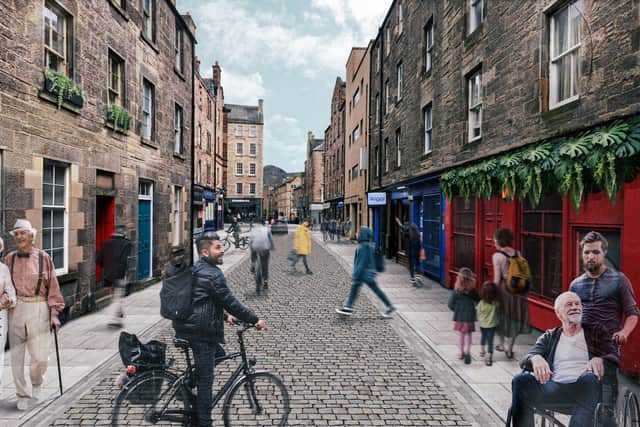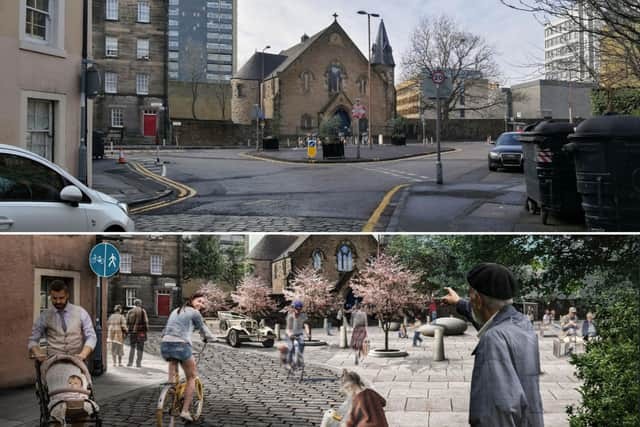Edinburgh residents plan to transform ‘neglected traffic island’ into community space on West Crosscauseway
and live on Freeview channel 276
A community led campaign to transform a ‘neglected traffic island’ into a welcoming community space in Edinburgh’s southside is hoping to get the green light in the coming months.
The Causey Development Trust (CDT), a charity setup in 2011 to develop West Crosscauseway into a safer, more aesthetically pleasing and usable space for city residents, has been in consultation with local residents and businesses for a number of years – and organisers behind the initiative say local voices has shaped their proposed design that promotes cycling, walking and community relationships.
Advertisement
Hide AdAdvertisement
Hide AdIsobel Leckie, CDT secretary, said: “Up until the 1950s this was a historic triangular space where there was no traffic at all, where people celebrated New year, had bonfires, children played games and neighbours came out and had a gossip. We decided we wanted to transform it into a place more like that – not a place that was dominated by vehicles but a place for people.”


Local resident and CDT trustee, Robert Motyka, described the space in its current form as ‘a wasted opportunity.’ Mr Motyka said: “There is amazing architecture on both sides of the space and an amazing view of Arthur’s Seat – but most people don’t notice because they’re checking for cars when they cross the street, so instead of people enjoying this view it’s just an ugly traffic island.”
Design plans will allow cyclists to travel in both directions along the street and provide pedestrians with wider pavements, with the introduction of a nearby zebra crossing on Chapel Street, additional trees, a possible drinking fountain and cycle parking also part of the initiative.
In recent years the CDT’s proposal has been approved by local and national government and is applying for funding from Sustrans Scotland – and if successful, works could begin in 2024.
Advertisement
Hide AdAdvertisement
Hide AdDuring Covid lockdowns, residents began to use the ‘ugly traffic island’ as a meeting place, establishing ‘Saturday Sit Oots’ to meet up, get to know each other and have a coffee. The move not only strengthened the community and further inspired the design but also enhanced the aesthetic of the urban space by when residents introduced planters donated by Inch Nursery.


Robert said: “A lot of people passing by commented on how great the idea is – to transform the traffic island into a community space. One local woman who didn’t know many people in the area said our ‘Sit Oots’ were a great way to get to meet other neighbours. The lockdowns changed a lot of people’s perspective on public spaces, if you don’t have a garden for example, and also about the relationship with your neighbours. My view on the Causey is finding organic ways of people who live on the street to create some projects together.”
One such project took place last February when the trust collaborated with a local school, projecting their artwork onto the surrounding walls in a community event that saw hundreds attend.
Isobel said: “Residents didn’t wait for the space to be made, they just started using it and brought it to life, so it’s been an enormous inspiration to me to have residents using the space and understanding what the project is about.”
Advertisement
Hide AdAdvertisement
Hide AdThough significant work has been carried out, Isobel said the project remains a ‘blank canvas’ with forthcoming decisions to be made on road surfaces, benches, bollards and cycle parking that reflects the areas heritage. She said: “Right from the beginning we wanted the Causey project to be an exemplar for other organisations who want to make their streets safer, cleaner, more geared up for active travel and generically more accessible, more attractive places for everyone.”
Comment Guidelines
National World encourages reader discussion on our stories. User feedback, insights and back-and-forth exchanges add a rich layer of context to reporting. Please review our Community Guidelines before commenting.